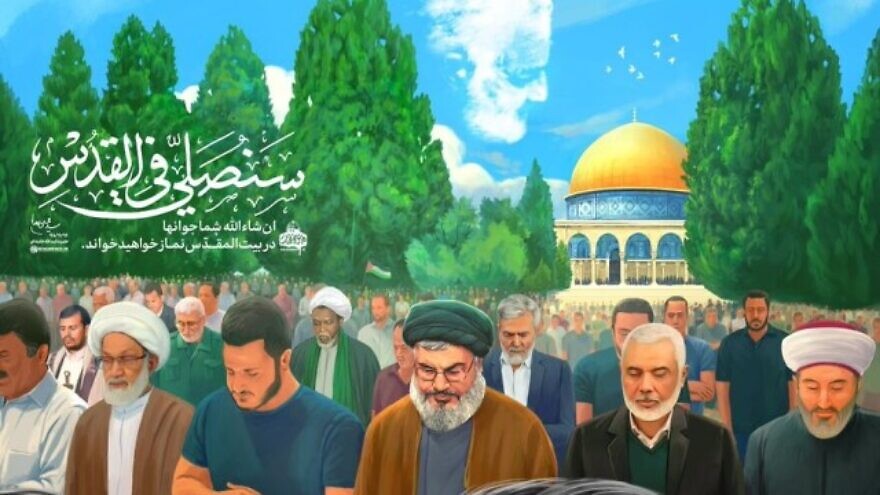The Iran-backed Hamas war with Israel in Gaza, now in its third month, continues to dominate international attention. However, there has been a simultaneous lack of strategic understanding that Hamas’s strategy of invasion, massacre, kidnapping and deception under cover of massive rocket attacks mirrors the Iranian regime’s Hezbollah strategy toward Israel’s north. The only difference is timing and execution.
Israeli military planners assess that Hezbollah would have undertaken the same pattern of invasion, mass murder, kidnapping and rocket attacks that Hamas carried out alone on Oct. 7, under Iranian supervision. Hezbollah’s invasion plan, utilizing its hundreds-of-kilometers-long tunnel system near northern Israel—similar to Hamas’s underground terror “metro”—could have resulted in thousands killed and kidnapped from Israel’s northern communities. Hezbollah’s Radwan force prepared an invasion plan to capture Israel’s northern towns and cities, including Kiryat Shmona, Metula and Nahariya.
Hamas and Hezbollah’s twin plans are no coincidence. Since the 2006 Hezbollah war against Israel, Iran’s Islamic Revolutionary Guard Corps has been preparing for a far larger, strategic, coordinated invasion. A massive Hezbollah build-up along Israel’s northern border violated United Nations Security Council Resolution 1701, which required Hezbollah to withdraw 20 kilometers (12.4 miles) north of Israel’s border, beyond the Litani River. The resolution intended to create a buffer zone that would have prevented the current stark reality of more than 100,000 Israelis evacuated from their homes in northern Israel. Unfortunately, UNIFIL (United Nations International Forces in Lebanon) failed to enforce the U.N.’s internationally guaranteed resolution.
The 3-H Club
Yet Israel has neglected to treat the Hamas-Hezbollah threat as part of a single integrated IRGC strategic campaign, designed by IRGC Quds Force commander Qassem Soleimani before his assassination in 2020 by the United States. The campaign includes the Houthi strategic threat to Red Sea shipping, and aerial assaults against Israel. The October 2022 gas deal Israel signed opposite Hezbollah-dominated Lebanon is a case in point. Negotiated by former Israeli Prime Minister Yair Lapid, it was part of a misconception that led Israel to believe that Lebanon under Hezbollah had become more concerned with its international legitimacy and energy supply than fueling terror against Israel.
Lapid depicted the gas agreement as a guarantor of Israel’s regional and international security, saying, “It is not every day that an enemy state recognizes the State of Israel, in a written agreement, in view of the entire international community…. It’s not every day that the United States and France stand behind us and provide security and economic guarantees for the agreement.” Yet Israel’s willful blindness was apparent: Lebanon’s then-President Michel Aoun emphasized that the agreement “has no political dimensions or impacts that contradict Lebanon’s foreign policy.”
Israel committed similar conceptual mistakes since the signing of the failed and strategically catastrophic Oslo Peace Accords between 1993 and 2004. Israel thought the PLO had become a more moderate diplomatic player, similar to its perception of Lebanon. However, Israel came to learn that the PLO-Palestinian Authority had financed, incited and incentivized terror against Israelis, providing between 35% and 50% of the P.A.’s annual budget to Hamas-controlled Gaza.
The Iranian regime also diverted Israel’s focus from Hamas in Gaza to terrorist activities in Judea and Samaria through terrorist actions by Iranian-backed groups such as the Lions’ Den, Palestinian Islamic Jihad, and Hamas in P.A.-controlled Nablus, Tulkarm and Jenin. At the same time, Iran’s “hidden hand” prepared its proxies in meetings in Beirut and Tehran to attack Israel from the north and the south.
IDF Lt.-Col. (res.) Sarit Zehavi, founder and president of the Alma Research and Education Center, in a strategic discussion in the Jerusalem Center for Public Affairs’ War Room Diplomacy webinar, noted that more than 100,000 Israelis have been displaced from Israel’s northern cities and towns. That fact only partially reflects fears that Hezbollah is still planning to execute an operation similar to Hamas’s “Al Aqsa Flood,” which included the torture and mass murder of 1,200 people, the kidnapping of 240 and the evacuation of civilian populations on Oct. 7, 2023, in southern Israel.
The Iranian regime’s proxy strategy, utilizing Hezbollah, Hamas and the Houthis, intends to put Israel in a no-win position of all-out multi-front war while benefiting from the West’s mistaken conviction that the Palestinian-Israeli conflict drives the Middle East’s regional instability.
The reality is different: The Iranian regime’s deception and disinformation, detailed in Harold Rhode’s book, “Modern Islamic Warfare,” encourage Western misunderstanding of the nature of Tehran’s intention to achieve regional supremacy under a nuclear umbrella. The Iranian regime knows that its radical Shi’ite eschatology remains an anomaly to the Western mind, and is thereby overlooked in its political, cultural and strategic conceptualization of Middle East policy.
For the West, it is much more comfortable to seek a territorial compromise with the Fatah-dominated P.A. leadership in Ramallah, which the Biden administration now insists should return to govern Gaza, despite Hamas’s violent overthrow of Fatah in 2007. Yet the P.A. finds itself competing with Hamas’s Islamic extremism to retain the PLO’s revolutionary status, while the West Bank Arab population views the P.A. as corrupt and weak, with over 75% of the population now supporting Hamas, according to recent polls.
The American-led Western alliance’s misunderstanding of the sources of regional terror and subversion has undermined Israel’s position and legitimacy. As early as 2000, PLO leader Yasser Arafat said that the P.A. would adopt the “Hezbollah strategy.”
The mistaken Oslo paradigm adopted by Israel and the West lent the P.A. and Hamas diplomatic legitimacy, while Israel’s territorial retreat from Judea, Samaria and Gaza led to countless acts of terror, including rocket fire, tunnel terror and other direct actions, culminating in the atrocities of Oct. 7, 2023. More than 220,000 Israelis are now refugees in northern and southern Israel. Yet, ironically, in the Western discourse, Hamas’s atrocities have put it on par with Fatah’s “freedom fighting” and raised its relevance and legitimacy in some circles in the West to that of the P.A.
The Iranian regime’s messianic determination to eliminate Israel as the “Little Satan,” as part of its decades-long plan to destroy the United States, the “Big Satan,” can only be defeated by eliminating the source of the threats, whose hidden hand continues to challenge Israel’s existence and the stability of the entire region. Military victory against Hamas and Hezbollah, and even the Iranian regime, is insufficient. Israel must change its communication strategy to increase regional and international awareness of the dangers posed by the Iranian axis of radical Islamic terror—in the media and on the diplomatic and human rights battlefields.
Originally published by The Jerusalem Center for Public Affairs.


























